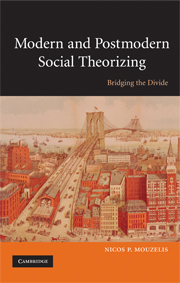Book contents
- Frontmatter
- Contents
- List of figures
- Acknowledgements
- Introduction
- Part I The theoretical background: the development of the agency–structure problematic
- Part II Parsonian and post-Parsonian developments
- Part III Agency and structure: reworking some basic conceptual tools
- Part IV Bridges between modern and late/postmodern theorizing
- 9 Modernity: a non-Eurocentric conceptualization
- 10 Ethical relativism: between scientism and cultural relativism
- 11 Cognitive relativism: between positivistic and relativistic thinking in the social sciences
- 12 Social causation: between social constructionism and critical realism
- Part V Towards a non-essentialist holism
- Instead of Conclusion: Twelve rules for the construction of an open-ended holistic paradigm
- Appendix: In defence of ‘grand’ historical sociology
- References
- Index
12 - Social causation: between social constructionism and critical realism
Published online by Cambridge University Press: 05 June 2012
- Frontmatter
- Contents
- List of figures
- Acknowledgements
- Introduction
- Part I The theoretical background: the development of the agency–structure problematic
- Part II Parsonian and post-Parsonian developments
- Part III Agency and structure: reworking some basic conceptual tools
- Part IV Bridges between modern and late/postmodern theorizing
- 9 Modernity: a non-Eurocentric conceptualization
- 10 Ethical relativism: between scientism and cultural relativism
- 11 Cognitive relativism: between positivistic and relativistic thinking in the social sciences
- 12 Social causation: between social constructionism and critical realism
- Part V Towards a non-essentialist holism
- Instead of Conclusion: Twelve rules for the construction of an open-ended holistic paradigm
- Appendix: In defence of ‘grand’ historical sociology
- References
- Index
Summary
Introduction
It must be pointed at the very start that the terms used to define the debate between social constructionists and critical realists are often misleading. They seem to imply that the differences between the two sides have to do with whether such phenomena as social structures are real or mere fictions in the minds of social scientists. In fact, the actual debate is concerned less with the ‘reality’ of structures than with how real social structures are constructed and what exactly they do, what kind of impact they have on social stability and change.
If we take, for instance, the exchange of views between Rom Harré and Bob Carter in a symposium published in the European Journal of Social Theory, it is not only the critical realist Carter who believes in the real existence of structures; Harré also states emphatically that social structures, although discursively constructed, are the real products of acting agents. They both, therefore, start by accepting, ontologically speaking, the real existence of structures. They differ, however, on the way in which real structures impact on social action and interaction.
For Carter (following Bhaskar, 1978, 1989; Archer, 2000), social structures have ‘causal powers’, whereas for Harré only human agents have such powers. Social structures can in themselves cause nothing:
At the end of the day I hope to show that such referents [i.e. referents of social structure expressions] are not the kind of entities that could be causally efficacious. […]
- Type
- Chapter
- Information
- Modern and Postmodern Social TheorizingBridging the Divide, pp. 191 - 214Publisher: Cambridge University PressPrint publication year: 2008



